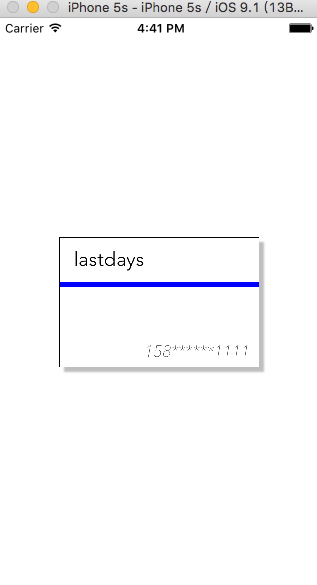iOS设计模式-适配器
发布于 2016-04-10 15:56:48 | 164 次阅读 | 评论: 0 | 来源: 分享
iOS苹果移动操作系统
苹果iOS是由苹果公司开发的移动操作系统。苹果公司最早于2007年1月9日的Macworld大会上公布这个系统,最初是设计给iPhone使用的,后来陆续套用到iPod touch、iPad以及Apple TV等产品上。
为何使用适配器?
直接赋值的缺点
最简单明了就是直接写一个示例来说名
制作一张卡片:

对卡片的数据直接赋值:
#import "ViewController.h"
#import "BusinessCard.h"
@interface ViewController ()
@end
@implementation ViewController
- (void)viewDidLoad {
[super viewDidLoad];
// Do any additional setup after loading the view, typically from a nib.
BusinessCard *card = [[BusinessCard alloc] initWithFrame:BUSINESS_FRAME];
card.name = @"姓名";
card.color = [UIColor blueColor];
card.phoneNumber = @"电话";
card.center = self.view.center;
[self.view addSubview:card];
}
- (void)didReceiveMemoryWarning {
[super didReceiveMemoryWarning];
}
@end
运行结果:

非常简单的一个示例,这基本上就是我们以前经常使用的一种方法直接赋值,这种的缺点,其实很简单,就是耦合性太强了,简简单单的移除更改,可能就会造成很多地方进行更改。现在看起来很简单就更改,但是如果我们的数据很多很多呢?
因此我们现在简单的来改进一下,设计一个model。并且在BusinessCard添加如下代码:
/**
* 初始化数据
*
* @param model BusinessCard
*/
-(void)loadDataWithModel:(Model *)model{
self.name = model.name;
self.phoneNumber = model.phoneNumber;
self.line = model.lineColor;
}
ViewController:
@interface ViewController ()
@end
@implementation ViewController
- (void)viewDidLoad {
[super viewDidLoad];
// Do any additional setup after loading the view, typically from a nib
Model *model = [[Model alloc] initWithName:@"lastdays" phoneNumber:@"158******1111" lineColor:[UIColor blueColor]];
BusinessCard *card = [[BusinessCard alloc] initWithFrame:BUSINESS_FRAME];
card.center = self.view.center;
[card loadDataWithModel:model];
[self.view addSubview:card];
}
- (void)didReceiveMemoryWarning {
[super didReceiveMemoryWarning];
}
@end
这样就降低了一些耦合性,这就是以对象形式赋值。
但是我们现在来阐述一个很致命的问题,那就是如果我们来了一个新的Model数据类型,其中的UIcolor是二进制形的。跟我们原来处理的数据类型不符合?这个时候怎么办?
其实解决方案很简单,这也就是上面提到过的,电源适配器原理。
使用适配器模型
电源有输入和输出,当然我们先来构建适配器
CardAdapterProtocol:
#import <Foundation/Foundation.h>
#import <UIKit/UIKit.h>
@protocol CardAdapterProtocol <NSObject>
- (NSString *)name;
- (UIColor *)lineColor;
- (NSString *)phoneNumber;
@end
CardAdapter:
#import <Foundation/Foundation.h>
#import "CardAdapterProtocol.h"
#import <UIKit/UIKit.h>
@interface CardAdapter : NSObject<CardAdapterProtocol>
/**
* 建立输入关系
*/
@property(nonatomic,weak) id data;
/**
* 与输入对象建立联系
*
* @param data 输入的对象
*
* @return 当前实例对象
*/
- (instancetype)initWithModel:(id)data;
@end
```
``` bash
#import "CardAdapter.h"
@implementation CardAdapter
- (NSString *)name{
return nil;
}
- (UIColor *)lineColor{
return nil;
}
- (NSString *)phoneNumber{
return nil;
}
@end
这里我们构建了CardAdapterProtocol协议,以及抽象类CardAdapter,接下来就是创建ModelCardAdapter,这就是针对Model构建的适配器,然后覆盖内部方法进行重写。
这里需要做一下说明CardAdapter中通过initWithModel建立与Model的输入关系,就是我们在国内用充电器给手机充电,CardAdapter与Model的关系就是充电器跟220V电压的关系。
接下来就该建立充电器跟手机的关系了,这里面相当于构建CardAdapter和View的关系。
BusinessCard
/**
* 初始化卡片数据
*
* @param model BusinessCard
*/
-(void)loadDataWithModel:(id<CardAdapterProtocol>)data{
self.name = [data name];
self.phoneNumber = [data phoneNumber];
self.line = [data lineColor];
}
这样,我们基本上就完成了构建,测试:
ViewController:
#import "ViewController.h"
#import "BusinessCard.h"
#import "Model.h"
#import "ModelCardAdapter.h"
@interface ViewController ()
@end
@implementation ViewController
- (void)viewDidLoad {
[super viewDidLoad];
// Do any additional setup after loading the view, typically from a nib.
Model *model = [[Model alloc] initWithName:@"lastdays" phoneNumber:@"158******1111" lineColor:[UIColor blueColor]];
//建立充电器跟电源关系
CardAdapter *cardAdapter = [[ModelCardAdapter alloc] initWithModel:model];
BusinessCard *card = [[BusinessCard alloc] initWithFrame:BUSINESS_FRAME];
card.center = self.view.center;
//建立手机跟充电器关系
[card loadDataWithModel:cardAdapter];
[self.view addSubview:card];
}
- (void)didReceiveMemoryWarning {
[super didReceiveMemoryWarning];
}
@end
测试结果:

以上我们使用的就是类适配器,当然还有一种叫做对象适配器,就是说无论我们是220V,还是100V,用这一个充电器都能给手机充电。这种如何实现?简单的说就是我们可以构建一个Adapter继承CardAdapter,简单的举个例子
Adapter
- (NSString *)name {
NSString *name = nil;
if ([self.data isMemberOfClass:[Model class]]) {
Model *model = self.data;
name = model.name;
} else if ([self.data isMemberOfClass:[NewCardModel class]]) {
NewCardModel *model = self.data;
name = model.name;
}
return name;
}
根绝对象类型进行判断返回哪种处理结果。这种其实并不推荐,因为什么?因为现在的数据模型比较少,如果有10个,20个数据模型,那这个类到最好会非常的臃肿,并不方便我们维护。
总结
优点
优点显而易见,就是让适配器可以让我们的View更加强大,可以适配不同的数据,降低我们的耦合性
缺点
其实在代码中就可以看出来,一个简单赋值的东西,用了这么多东西,比较麻烦,有的时候是很繁琐的。但是呢?话又说回来,我们如果做了一个很牛的控件,为了提高它的通用性,加一个适配器会更好一些。 当我们的代码能力增加。但是呢? 这同样也是一个缺点,那就是代码的可读性不好。这点的权衡就靠自己来衡量,虽然麻烦一些,但是确实能够提高扩展性。